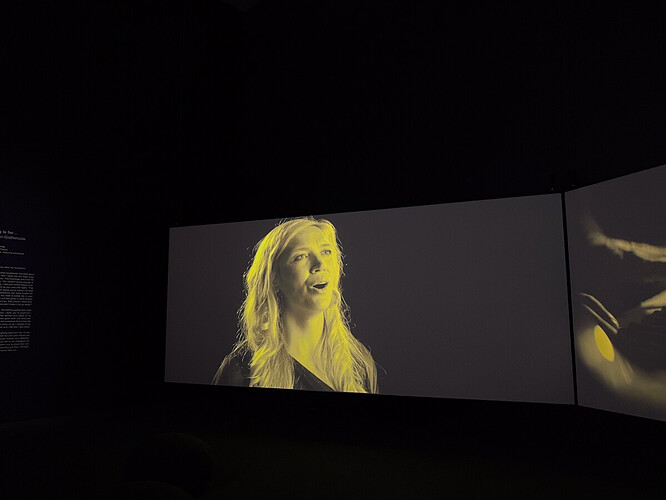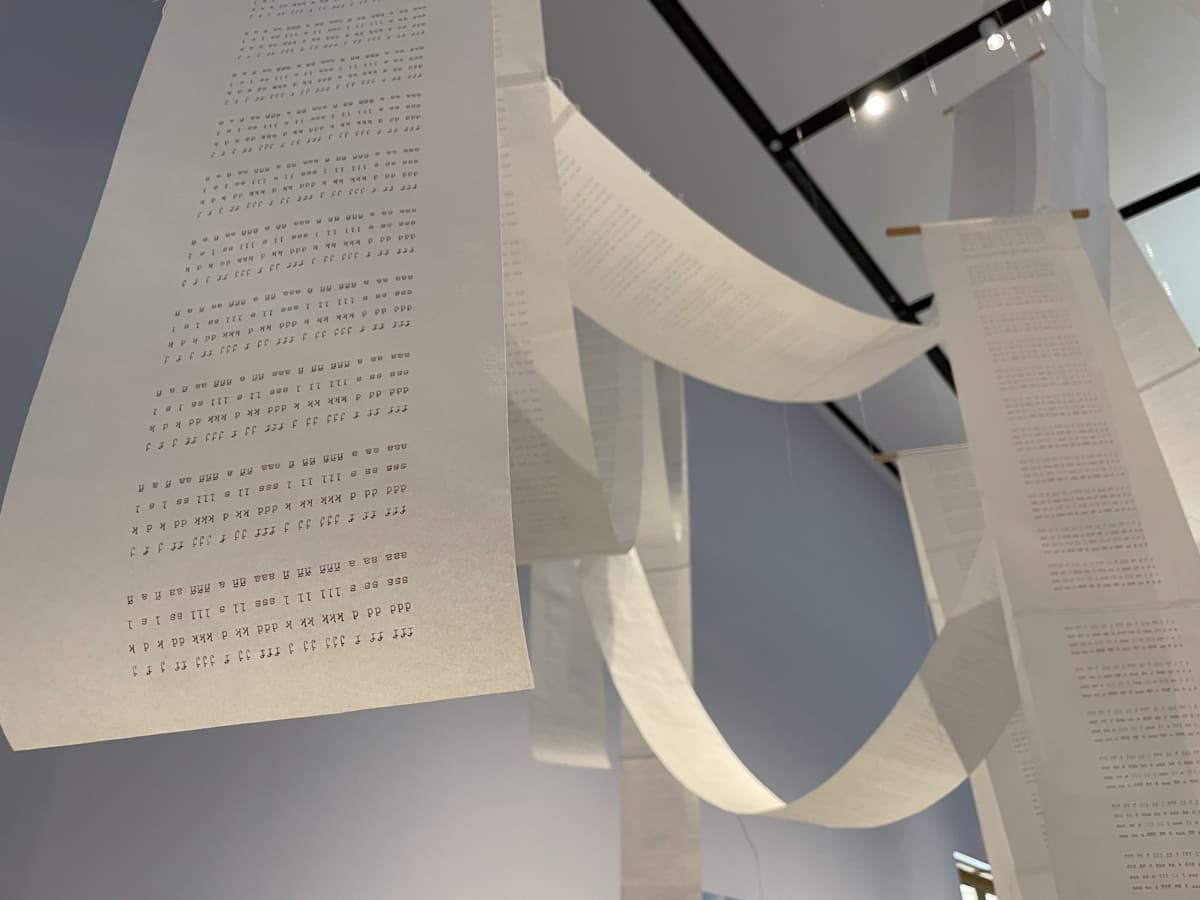Cantando Bajito: Testimonies
Curated by Isis Awad, Roxana Fabius, and Beya Othmani
at the Ford Foundation Gallery
Translated into English as “singing softly,” the exhibition series title is drawn from a phrase used by Dora María Téllez Argüello, a now-liberated Nicaraguan political prisoner, to describe the singing exercises she did while she was incarcerated in isolation. Helping her to conserve her voice and defeat the political terror she endured, Téllez’s quiet singing became a powerful strategy for survival and resistance. Conceived in three movements, Cantando Bajito features artists who explore similar forms of creative resistance in the wake of widespread gender-based violence.
I attended Cantando Bajito: Testimonies three times: first, guided by the curators (Isis Awad, Roxana Fabius, and Beya Othmani); next to experience Gabrielle Goliath’s video installation, This song is for…, in its entirety (I think it was and hour & 40 minutes long), and last: to pass through the exhibition on my own, with the curator’s checklist notes informing my experience.
You can see the checklist here — I quote it throughout this post. I didn’t get photos of everything, but I wanted to share what I have…
So, Sylvia Netzer’s Glen-Gery Olympia meets you at the entrance. The first of a series of large works that reference Manet’s “Olympia,” and address issues of female sexuality and power.
She welcomes us into a place of embodied reversal and resistance.
Glen-Gery Olympia, 2004, Carved brick and encaustic by Sylvia Netzer
Glen-Gery Olympia, a monumental work in the form of a reclining woman composed of hand-carved terracotta bricks, is a clear example of how Netzer combines both the personal and the systematic. Giving her personal experience space and size, grounded in embodiment, Netzer’s work shows art’s unique power to share understanding of others’ experiences of being.
A note of care
I really liked this way of addressing the concept of a trigger warning: a note of care.
A note of care regarding This song is for… by Gabrielle Goliath: This is a work of survival.
From the Barricades
1980-97
Archival pigment prints
by Sheba Chhachhi
In From the Barricades, Chhachhi revisits her archive of documentary images made between 1980 and the late 1990s to explore how both the self and the collective are formed through protest and resistance.
Novias Revolucionarias (Revolutionary birdes)
1968-69
Left to Right: I, V, II, XI, IV,
Woodcut
by Leonilda González
The series presents multiple bride characters seen at the moment of their wedding. When their presumed marital life of love and happiness is supposed to begin, González represents them as angry and performing acts of protest and rejection of a system that will “imprison” them.
Omalutu, omeli medu eli/Our bodies are within this soil
2022
Image transfer, mahangu, resin, acrylic ink, cotton embrodiery thread, and rusted cotton fabric canvas
by Tuli Mekondjo
Mekondjo is a Namibian artist whose practice addresses the search for restitution and repair in the shadow of Namibia’s violent colonial past. Drawing on colonial archives extracted from Namibia during the German colonial period (1884–1920) and the illegal occupation by South Africa (1965–1990), the artist conjures the presence of Namibian women who labored as domestic workers during these eras. Imagining a reversal of the colonial gaze, her canvas performs a transformative healing and honoring of interrupted female ancestral lineages.
Cantando Bajito: Testimonies room view 1
Performing… and Performers…
2013 and 2011
(left to right)
Watercolor
by Lalitha Lajmi
Drawing inspiration from her own life, her largely autobiographical artwork contemplates gender roles and patriarchy. Metaphorical images of dream sequences, relationships,and performances recur across her works. The performer figure in these works, often portrayed as a clown, represents gendered roles she performed in her own domestic life. The motif of the mask signals the concealment of one’s true identity, feelings, and aspirations while performing.
Cantando Bajito: Testimonies room view 2
When I came back the second time, I sat on a bench in a dark room and watched the video installation of beautiful singing of songs chosen by survivors of sexual assault, where the performers enacted the experience of a scratch on a vinyl record by repeating a piece of the lyrics over and over and over and over again. It was beyond what I would have thought anyone could take - to pay such close attention and repeat, repeat, repeat, repeat. Repeat. But that is how trauma works on us, isn’t it. Hardly anyone came in so I could just listen and cry, which felt good to do.
I didn’t think to make a note of the names of the songs. Around me, on the walls there were panels naming the songs and the survivor (if they want to be named) and holding a statement from them about their experience, how they feel now, and naming the performers.
This song is for…
(2019-)
2-channel video installation
by Gabrielle Goliath
Gabrielle Goliath generates in her practice spaces that sensitively address gendered and sexualised violence. On entering the gallery dedicated to This song is for . . . , audiences encounter a collection of dedication songs, each chosen by a survivor of rape. These are songs of personal significance to the survivors, evoking memories and feelings. However, at particular moments in each song — and often comfortingly familiar ones — the notes are disrupted like a broken record or a repeating scratch in memory.
As collaborators on the project, the survivors shared not only their songs, but also a color of their choosing and a written reflection. The artist then worked closely with women- and gender-queer-led musical ensembles to reinterpret and re-perform the songs.
This song is for… (2019-), 2-channel video installation by Gabrielle Goliath screenshot from survivor song a
This song is for… (2019-), 2-channel video installation by Gabrielle Goliath screenshot from survivor song b
This song is for… (2019-), 2-channel video installation by Gabrielle Goliath screenshot from survivor song c
This song is for… (2019-), 2-channel video installation by Gabrielle Goliath screenshot from survivor song d
Plano
2014
Rice paper, typed text
by Abigail Reyes
Before devoting herself fully to her art and poetry practice, Abigail Reyes studied and worked as a secretary. This experience deeply influenced her approach to artmaking and is particularly visible in Plana.
The piece is composed of sheets of paper with repeated lines from a secretarial-training typing manual which are held together by embroidery and suspended overhead. Objects and tools associated with work viewed as women’s professions, seldom seen in public, are thus transformed into a way of openly voicing the inequities of that work.
Cantando Bajito: Testimonies room view 3
BLACK BODIES
2018-2021
Closed-captioned video, hot-red, 1 loop with voice/audio, 1 loop without voice/audio
by Keioui Keijuan Thomas
Keioui Keijaun Thomas is a New York-based artist. She creates live performance and multimedia installations that address Blackness outside of a codependent, binary structure of existence. Her performances combine rhapsodic layers of live and recorded voice, slipping between various modes of address to explore the pleasures and pressures of dependency, care, and support.
Glen-Gery Olympia
2004
Carved brick and encaustic
by Sylvia Netzer
…On the way out, I realized that Glen-Gery Olympia had been holding space for us the whole time.
















